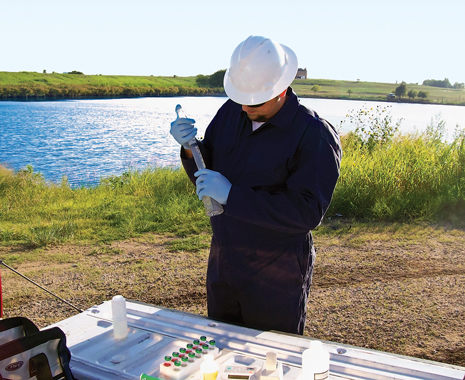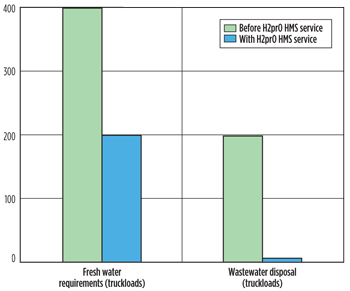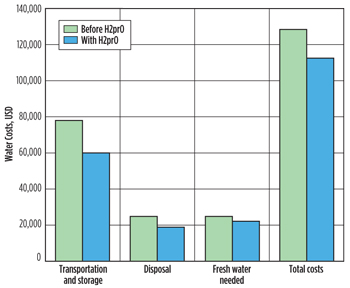PRAMOD KULKARNI, Editor
 |
| A Baker Hughes field chemist draws a sample from a pond for pretreatment water analysis. |
|
According to a produced water study conducted by Douglas-Westwood and OTM Consulting Research in 2010, daily water production volumes for the oil and gas industry significantly exceed that of oil volumes, to the extent that 211 MMbwpd are produced, compared to around 85 MMbopd. While few companies track life cycle water management costs, Baker Hughes suggests $11 billion as the best annual cost estimate for surface water treatment and disposal in the U.S. Baker Hughes has developed services for surface water management as well as to minimize produced water through downhole solutions, such as gel injections and relative permeability modifiers.
SURFACE WATER TREATMENT CHALLENGES
An effective water management strategy requires a comprehensive, integrated view of surface water challenges. The sequence of steps includes pre-treatment sampling, analysis and testing at onsite, mobile laboratories, and at full-service laboratories to determine the water’s chemistry and to design the most effective fracturing fluid. Post-treatment water analysis will ensure that water quality requirements were met.
In the U.S., water quality and disposal regulatory standards vary state by state. The U.S. Environmental Protection Agency (EPA) has national jurisdiction via the Clean Water Act. Knowledge of the applicable standards is a prerequisite to designing cost-effective recycling and disposal programs.
“It is first necessary to understand the constituents in produced and flowback water to design an effective fracturing fluid. Equally important, we need to know to what extent the water must be treated,” said Steve Monroe, Product Line Manager for Surface Water Treatment at Baker Hughes. “Treating water just enough for reuse dramatically reduces costs.”
WATER CONTAMINANTS & TREATMENTS
Baker Hughes has developed its H2prO water management service that offers comprehensive surface water management capabilities that extend from chemical analysis to customized treatment; recycling as frac water; storage; and disposal, according to local regulatory standards. The service depends on several treatment options for a variety of water contaminants.
Following is an explanation of the typical water contaminants and possible treatment solutions.
Solids removal. In some cases, water treatment can be as simple as removing the suspended solids in the water. For these projects, a filtration system removes contaminants suspended in the water, using filter cartridges, or socks, and recovers virtually all of the water for reuse. It is inexpensive, requires minimal energy, and adapts easily to changing water conditions. Units are available to treat up to 10,000 bwpd.
Heavy metals and solids removal. Heavy metals and suspended solids can have a significant impact on the effectiveness of the hydraulic fracturing fluid, and, potentially, cause scale and corrosion in the wellbore. To treat these issues, Baker Hughes uses a patent-pending electrocoagulation (EC) process for onsite removal of suspended solids and heavy metals. The process introduces an electrical current into the water to destabilize suspended, emulsified or dissolved contaminants. The electrical current creates an electromotive force, causing chemical reactions. The Baker Hughes EC process eliminates the electrode fouling or corrosion that is typical in traditional EC systems, thereby reducing the potential for nonproductive downtime and escalating treatment costs. The system can process up to 8,500 bwpd with no influent water restrictions on dissolved or suspended solids.
H2S remediation and bacterial disinfection. H2S and bacteria, in produced and flowback water, can cause downhole scale and corrosion, equipment plugging and gel degradation in the hydraulic fracturing fluid; a biofilm at the reservoir face; and HS&E concerns. Chlorine dioxide (ClO2) chemical remediation, which has been used downhole and in refineries for decades, is a cost-effective solution to treat these constituents in surface water in tanks, reserve pits, impoundments, ponds, and injection or disposal wells. The onsite CIO2 treatment service kills bacteria and neutralizes H2S, iron sulfide, polyacrylmide and polymers in produced and flowback water with a smaller footprint, lower power costs, and reduced manpower needs, compared to other solutions.
Desalinization and total dissolved solids removal. Total dissolved solids (TDS), which are primarily made up of salt, can cause scale and corrosion in the wellbore, and in associated equipment during a hydraulic fracturing operation. Baker Hughes offers a desalinization service to generate a high purity level in the treated water. This mobile system processes more than 1,700 bwpd, with TDS levels of up to 128,000 ppm, and recovers up to 75% of the water as a distillate with <300 ppm TDS. A pretreatment system, designed to remove dissolved iron and manganese to less than 5 ppm, is included in this service. The remaining concentrated sterile brine from the system can be treated further, used as a kill fluid, or prepared for disposal.
Clarification. If left untreated, high hardness in some produced waters can negatively impact fracturing fluid formulation and can cause irreversible scale damage. Clarification of the produced water is the only viable solution to lower hardness levels and designing a successful fracturing fluid. Special testing is done to further ensure compatibility with formation fluids. Then, a complete treatment package, that includes long-term scale inhibitors, is designed to safeguard the integrity of the completion components and the formation.
SURFACE WATER TREATMENT CASE HISTORIES
Several case studies from the Permian basin in West Texas and eastern New Mexico illustrate the environmental and economic values of recycling frac flowback, and produced water for hydraulic fracturing.
Treating produced water for fracing. During a recent hydraulic fracturing program in the Permian basin, the operator was interested in reusing produced water to offset the expense of sourcing and trucking freshwater for use in hydraulic fracturing fluid, and by eliminating the need for transporting and disposing wastewater.
The hydraulic fracturing job consisted of nine stages, requiring more than 1,300 bbl of frac fluid per stage. Baker Hughes recommended a water treatment solution to facilitate use of onsite produced water in the fracturing fluids. A pretreatment water analysis revealed that both the influent and effluent water samples contained high concentrations of hydrogen sulfide (H2S) and organics. Based on these findings, chlorine dioxide (CIO2) green chemistry was used to neutralize bacteria, H2S, iron sulfide, phenols, mercaptans and polymers. Following the treatment, the water was suitable for reuse, with no negative impact to the producing formation or to downhole equipment, and residual hydrocarbons could be recovered from the wastewater. A total volume of 3,400 bbl of treated water was successfully used in the polymer-based, cross-linked hydraulic fracturing fluid. Post-job analysis confirmed that the treatment was more than sufficient, using 100% of the treated water with no dilution for the job design of two frac stages. By eliminating freshwater and disposal costs, the operator’s overall operating expenses for the project were reduced by 30%.
Treating flowback water for reuse. A West Texas operator, with wells in Reagan and Irion Counties, was using fresh water for hydraulic fracturing, while fracture flowback water with drilling waste was being trucked off to disposal sites. To reduce freshwater consumption and disposal costs, an innovative, patent-pending electrocoagulation technology was used to remove heavy metals and suspended solids from the water. About 16,000 bbl of the treated water was tested and then used to formulate a crosslinked polysaccharide-based fracture fluid. The treatment was pumped at rates of 60 to 65 bpm throughout a six-stage fracture, at treating pressures of 5,000 to 5,500 psi. Each fracture job used more than 500,000 gal of water and 500,000 lbm of fracture sand. Initial resulting production was 75 bopd, slightly higher than the expected field average. At the same time, transportation and disposal costs were reduced 98%, freshwater usage was reduced 50%, and overall operating costs were reduced 20%, Fig. 1.
 |
| Fig. 1. Treating produced and flowback water for reuse in fracturing fluid yields increased production and cost savings. |
|
Treating complex, produced and flowback water for reuse. An operator in the New Mexico area of the Permian basin requested a pilot project to analyze its produced and flowback water, and develop a treatment solution for recycling the water in a hydraulic fracturing fluid. Pre-treatment water analysis indicated highly variable levels of emulsified and free oil, suspended solids and iron, and a low pH level. The solution included the H2prO HMS and SR systems for heavy metals and solids removal, plus sufficient chemicals to maintain the optimal pH.
The Baker Hughes water management team deployed a treatment system consisting of filter pods with 10-µ filter socks and a three-compartment weir tank. Water was trucked to location from various wellsites around the field in southeast New Mexico and five, 500-bbl frac tanks were used for raw water storage. A total of 6,200 bbl of produced and flowback water was treated over three days. Following treatment, the water was transferred to 12, 500-bbl frac tanks for final use. All 12 frac tanks were manifolded together for ease of use by the hydraulic fracturing contractor.
Successful hydraulic fracturing fluid was formulated with the treated, produced and flowback water. Post-treatment analysis showed that the treatment solution exceeded customer requirements, reducing iron content from 23 ppm to less than 2 ppm and improving the pH level from 6.5 to 8.2. The hydraulic fracturing contractor was given samples of the processed water prior to the fracturing job, to ensure that proper crosslinking had occurred. The treatment lowered overall operating expenses by 12%, and transportation and storage costs by 23% on just one stage of a 10-stage fracturing operation, Fig. 2. Based on this project’s success, the operator plans to expand the reuse of produced and flowback water in its hydraulic fracturing operations.
 |
| Fig. 2. The water management service lowered overall operating expenses by 12%, and transportation and storage costs by 23%, on just one stage of a 10-stage fracturing operation. |
|
Treating challenging flowback and produced water to reduce fracturing expenses. An operator working in the Permian basin was facing high costs to source fresh water for hydraulic fracturing operations and to dispose of flowback water. Recognizing the constantly changing conditions of produced and flowback water in the area, Baker Hughes developed a sampling and testing program to ensure full characterization of water quality and selection of an optimum treatment solution. The testing program included formulating the fracturing fluid using the treated water in a lab setting, to ensure that the treatment design would meet the operator’s requirements.
Twice during the water treatment design, the source water quality changed. Oil and grease content ranged from 100 to 2,000 ppm, iron from 50 to 140 ppm, and turbidity from 200-300 FAU. Electrocoagulation technology was able to reliably remove contaminants and adjust to the changing water quality. Following the water treatment, the fracturing program was completed, as planned, using 500 bbl of water for each of the six stages. Average flowrates and surface pressures, during the stage using the treated water, matched those of the five other stages. The operator realized reduced expenses of more than 60%, as the result of a viable alternative to costly fresh water, and the elimination of transportation and disposal of produced and flowback water. Based on the success of this pilot project, a second water treatment job is being designed for this operator.
INTEGRATED SUBSURFACE WATER MANAGEMENT
The best strategy to reduce surface water treatment costs is to minimize produced water at the subsurface. Baker Hughes has developed integrated water shutoff and conformance solutions that reach deep into naturally fractured or mechanically fractured reservoirs to enhance hydrocarbon production while minimizing excessive subsurface water production. “Effective use of such subsurface treatment capabilities is dependent on expertise, knowledge and diagnostic methods, including reservoir modeling capabilities, to accurately analyze water production problems and implement the proper solution to achieve the desired goals,” explained Freeman Hill, Product Line Manager, Subsurface Water Management at Baker Hughes.
| Table 1. Gel systems applications matrix |
|

|
Several polymer systems are available to shut off water production that can be customized for specific downhole conditions, Table 1. Specific gel treatment applications include:
MARCIT-CT gel treatment. Hydrocarbon reservoirs typically contain mixtures of reservoir attributes, some of which are more conducive to flow. These more conductive features are often naturally-occurring fractures or other secondary porosity features. The MARCIT-CT treatment preferentially blocks these high-flow pathways to improve production from unswept portions of the reservoir. Benefits include reduced water and CO2 production for lower operating costs and increased oil production.
CAPIT gel treatment is a high-temperature, high-strength version of the MARCIT-CT gel system, and is often used in conjunction with a MARCIT-CT treatment as the final cap to a large reservoir conformance treatment. The properties of the CAPIT gels are very similar to a standard MARCIT-CT treatment, but the gel is much stronger and has higher temperature stability.
UNOGEL high-strength gel uses an organic cross-linker, which extends capabilities in reservoirs with temperatures in excess of 300°F, with the same benefits of MARCIT-CT. The UNOGEL system reduces the flow in fractures without penetrating the matrix. Its low leak-off properties are suitable for conformance improvement in dual-porosity reservoirs. In those situations where gas production is undesirable, the UNOGEL technology can be injected into matrix permeability to completely block the offending zone. The system was developed to provide stable gels with sufficient working time to allow their placement in more demanding environments.
FracBlock gel was developed specifically for the treatment of hydraulically fractured wells in unconventional reservoirs, such as shale plays. The gel operates in higher-temperature reservoirs (250°F), treats propped fractures, penetrates deeper into the microfracture system, and withstands significant pressure differential. The benefits include reduced water production and increased oil or gas production.
MARA-SEAL gel uses a low-molecular-weight, cross-linked polymer that is injected directly into the target zone. Because of the low molecular weight and initial viscosity of this system, injection into small-diameter pore throats within matrix rock can be achieved, resulting in permeability reduction for total fluid shutoff. Benefits include reservoir penetration, permeability reduction shutoff and easy cleanout.
SILJEL fluids are solids-free water-shutoff treatment fluids that are pumped into permeable formations to form permanent plugs, which seal reservoir porosity and permeability. Ideal for shutting off unwanted water production, the fluids are nonselective, making placement a key consideration with these treatments. Benefits include low initial viscosity during pumping, good plugging efficiency and an internally activated system.
 |
| Fig. 3. Increase in oil production, and reduction in water production, as a result of gel treatment. |
|
Gel system case history. Gel treatment was performed for a 56-well section of a field suffering from excessive water production. As the low-permeability, low-porosity and naturally fractured field was marginally profitable, cement squeezes, usually used for water shut-off, were economically ineffective. Timing, temperature, and pressure of the injections were customized for the application, and the treatment was accomplished in 24 hr. As a result of the treatment, water production was reduced nearly 35%, from 6,100 bwpd to 3,950 bwpd, Fig. 3. The project achieved a seven-month payout. Three years later, production was virtually the same in 34 wells.
RELATIVE PERMEABILITY MODIFIERS, CEMENT SYSTEMS
In addition to gel systems, Baker Hughes offers other chemical-based technologies, such as relative permeability modifiers (RPM) and Magne-Block cement systems for reducing or eliminating water production under challenging conditions.
AquaFix RPMs reduce unwanted water production and are also suitable for near-wellbore profile modifications in waterflood injection wells. In production wells, the products are used in reservoirs producing excessive water through matrix flow from a water flow path that is isolated from hydrocarbon flow. The products are lithology-independent, have good shear tolerance and are compatible with most common stimulation fluids, scale inhibitors and heavy brines.
Magne-Block systems are acid-soluble, hard-setting, magnesium-based cement systems used for isolation behind pipe in carbonate and sandstone formations, including gravel pack completions. A principal application of Magne-Block systems is water shutoff in vertical and horizontal completions. Because Magne-Block treatment is acid-soluble, it can be either a permanent or temporary solution.
CONCLUSION
An extensive range of subsurface and surface solutions can be tailored for specific field conditions through operator-service company efforts to increase oil or gas production and reduce costs associated with freshwater sourcing, water transportation and wastewater disposal. 
|







